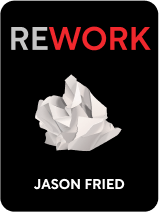

This article is an excerpt from the Shortform book guide to "Rework" by Jason Fried and David Heinemeier Hansson. Shortform has the world's best summaries and analyses of books you should be reading.
Like this article? Sign up for a free trial here .
Is strong momentum good for a startup? How can momentum derail your business from its intended direction?
All entrepreneurs are excited to see their venture grow. However, as your business’s momentum picks up, it’s easy to lose sight of which activities are worth your while.
To ensure your business isn’t derailing from your intended direction, follow these principles.
Principle 1: Constantly Analyze the Value of Your Efforts
Instead of just hammering away at a project, analyze the value of that project at frequent intervals. You need to know when your time would be better spent doing something else. To find out if your current work project is truly valuable, ask yourself these questions:
- Do you understand why you’re doing this project? What are the benefits of completing it? Who will benefit from it?
- Is the problem you’re trying to solve real or imaginary? On a scale of 1 to 10, how important is this problem?
- Is the project you’re working on truly beneficial, or is it just fun to work on?
- If you’re adding a feature or component to a product that already exists, are you adding quantifiable value to that product? Will the new feature have a big impact on how customers use your product, or are you just adding features that don’t really matter?
- Is there a much simpler solution to this problem or project you’re working on? Are you making this project too complicated?
- How would you be spending your time right now if you weren’t doing this project? What is this project keeping you from?
Principle 2: Know When to Drop a Project
It’s a lot smarter to abandon a project—even one that you’ve already put significant energy into—than to keep funneling resources into a dead end. Just because you’ve invested many hours of time and effort into something doesn’t mean you should keep investing more. Not every project is going to be a success.
If any project is taking you longer than two weeks to complete, get a colleague to take a look at your work. They might be able to find a solution that isn’t visible to you, or they might tell you the best solution is to drop the project. Either way, you’ll get a valuable reality check.
Principle 3: Build Uninterrupted Time Into Every Day
Build uninterrupted work time—a long period in which there is no talking—into your company’s regular work day. You get the most work done when you’re not interrupted by questions, conversations, or impromptu banter, all of which kill productivity.
When you’re repeatedly interrupted, you can’t get into the mental state in which deep thinking and productivity occur. Every time you experience an interruption, your brain endures a taxing “mental-switching” process. It’s forced to leave what it was happily working on, deal with the interruption, and then try to get back into the groove of what it was doing before.
To combat interruptions, set up your workday so that you and others on your team get critical “alone time” every day during normal business hours. For example, you might institute a company rule that no one may talk between 10 am and 2 pm each day. “Talking” includes any form of communication—no email, no instant messages, no meetings. Just turn the volume down to zero and take a deep-dive into work.
Communication and collaboration are critical to your business, of course. But whenever possible, choose communication channels like email, which allows people to respond when they’re ready—not when they’re in deep-thinking mode. Avoid communication that requires a right-now, drop-whatever-you’re-doing response, like walking into someone’s cubicle, calling them on the phone, or texting them.
(Shortform note: For more on the importance of blocking out time for focused work, read our summary of Deep Work by Cal Newport.)
Principle 4: Don’t Waste Time in Meetings
Meetings are notorious time-wasters. During a meeting, what could be said in 10 minutes often stretches out to 30. If you have six people in the meeting, that’s 180 minutes of productivity you just threw out the window. If you absolutely must schedule a meeting, follow these steps to save time:
- Set an agenda that includes a clear, specific problem to be solved.
- Limit the number of people in the meeting—fewer is always better.
- If possible, meet at the place where the problem is occurring, like at the assembly line or the customer service desk.
- Set an alarm to go off after an allotted period of time. When the alarm rings, the meeting ends.
- Find a solution before the meeting is over, and assign someone to put that solution into action.
Principle 5: Seek the Simplest Solution
When you’re looking for an answer to a problem, embrace the concept of “good enough.” Your goal should be to achieve maximum efficiency with minimal effort. Complex solutions waste time and resources, but “good enough” solutions get the job done quickly and to an acceptable standard.
Principle 6: Mark Small Wins in a Big Project
Long-term projects start to feel dull quickly. When you feel like you’ll never see the finish line, it’s easy to lose motivation. If you’re stuck on a long-term project, build in frequent “small wins”: markers that you can proudly announce to your colleagues and customers. Step-by-step achievement markers give you a chance to celebrate and share your success.
Instead of putting your head down and plugging away on a long-term goal, build in deadlines or progress markers at two-week intervals. Give yourself a “win” you can announce to the world.
Principle 7: Sleep More
Suggesting you sleep more may seem like odd business advice, but lack of sleep is detrimental to your business’s health as well as your personal health. When you miss out on sleep to finish a work project, your focus gets fuzzy. You make poor decisions. Your productivity slows down. Your creativity, demeanor, and morale suffer. The solution? Go home, go to bed, and tackle the problem tomorrow.
Principle 8: Estimate Small Projects, Not Big Projects
Human beings are terrible at making accurate projections, and the bigger the project, the more inaccurate we are. Most of us can’t correctly estimate how long it will take us to clean the house, let alone how long it will take us to remodel the house.
Even on massive public-works projects that have hundreds of analysts crunching the numbers, inaccurate estimates happen. For example, when the Denver International Airport was constructed, it cost $2 billion more than estimators predicted. It also took 16 months longer than expected. The project was simply too huge and had too many variables to be estimated accurately.
If you need to estimate how long a project will take or how much it will cost, break it into small chunks. You’ll still likely be wrong, but you’ll be wrong on a much smaller scale. Break your 12-week project into 12 one-week projects. After the first week, you’ll see that you were off by 25 or 50 or 75 percent, and you can adjust your estimates for the next 11 weeks.
Principle 19: Shrink Your To-Do Lists
Creating a long list of tasks to accomplish is both a guilt trip and recipe for failure. You won’t get everything done, and then you’ll feel bad.
Write a short to-do list instead of a long one. Divide big projects into small, attainable tasks. You’ll be able to accomplish everything on your list, which will raise your morale and motivate you to keep going.
Principle 10: Make Big Decisions in Small Steps
As a business owner, you might think your job is to make big, bold, sweeping decisions every day. But if you’re past the launch stage, bold decisions will only speed up your business’s momentum. Once they’re made, it’s hard to change them, even if they ultimately harm the business. To give yourself more latitude, make big changes in baby steps, one little decision at a time.

———End of Preview———
Like what you just read? Read the rest of the world's best book summary and analysis of Jason Fried and David Heinemeier Hansson's "Rework" at Shortform .
Here's what you'll find in our full Rework summary :
- Why the old-school process of starting a business doesn't work anymore
- Why you should completely ignore your business competition
- How to hire employees and help them thrive






